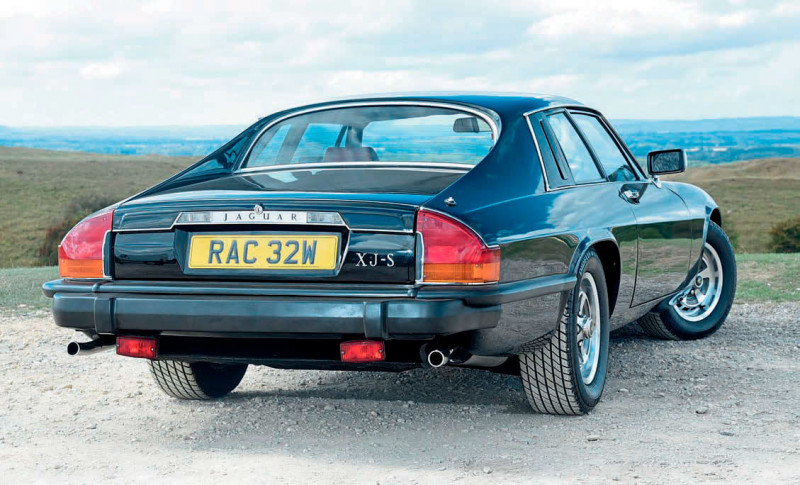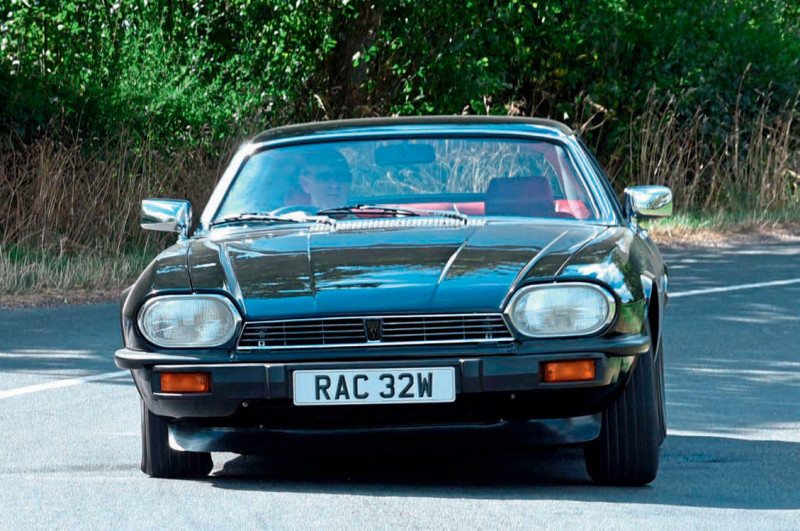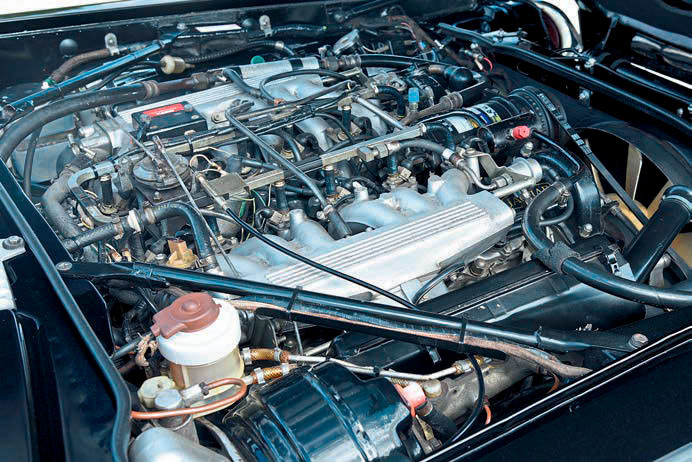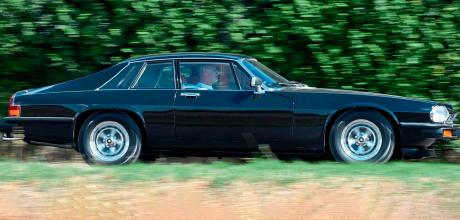1981 Jaguar XJ-S V12 Coupe P-Digital Manual
Although Jaguar had stopped offering the XJ-S with a manual gearbox in 1978, two were produced in the early Eighties which also had the Lucas P-Digital injection. We’ve tracked down what’s thought to be the sole survivor.
WORDS & PHOTOGRAPHY PAUL WALTON
XJ-S Unicorn! Mystery machine P-Digital Manual
XJ-S ODDITY We discover an XJ-S the history books say shouldn’t exist, offering a combination of the short-lived P-Digital injection and manual box
At first glance, this early XJ-S looks to be like any other of the 15,525 pre-HEs that were produced between 1975 and 1981, with only its pristine condition and the fact it’s survived the ravages of time setting it apart. Look closer, though, and you’ll see something that shouldn’t be there: a gear lever for a manual gearbox When the XJ-S was first launched, as well as a three-speed automatic gearbox it also had the option of a four-speed manual transmission which was never popular with customers or critics. “One of the less endearing aspects of the XJ-S is the transmission,” said Motor magazine in its February 21, 1976 issue. “The change is stiff and notchy if you rush it so it pays to ease the lever around rather than snatch it. However you treat it, the change is far removed from the flicks witch shifts we have come to expect of the most ordinary family saloons.”

With the three-speed automatic also more suited to a V12-engined grand tourer, in late 1978 and after just 352 production examples with the manual box had been produced, the option was discontinued. Therefore, it makes this 1981 car – plus a second example that was apparently made at around the same time – something of an anomaly.
Was it simply a special order for a favoured customer?

Since it was originally sold through Henlys of London, one of Jaguar’s oldest and most prestigious dealers, was it simply a special order for a favoured customer? According to former Jaguar test driver and XJ-S expert Ed Abbott, the right-hand-drive UK-specified car was built in the middle of a run of LHD export models meaning someone pulled strings to get it made. Ed suggests the car might have been produced as a present for Ed Mundy, one of the V12’s original designers, who retired at around the same time as the car left the Browns Lane assembly line.

Another, perhaps more credible theory, is the car was used by Jaguar’s development team. When current owner William Ireland contacted Jaguar Heritage in the early 2000s, not only did he discover it was one of two factory-made manuals produced during 1981, but the car’s build sheet listed the car as having a five-speed transmission. Jaguar did develop such a box in the early Seventies but it never reached production; was the car used to further test this transmission before being converted to a four-speed to be sold through Henlys? An interesting and convincing suggestion but since the car was produced in early 1981, a few months before the HE model went on sale, its usefulness as a test car was therefore limited.

With Henlys entering liquidation in 2005 following several takeovers and mergers, its sales ledgers have long since disappeared. So unless the first owner comes forward we’ll never know the car’s origins meaning it remains a bigger mystery than the Bermuda Triangle or Area 51. Yet the car’s history was the last thing on William’s mind when he first saw it advertised in June 1998. “I was visiting my sister in Oxford,” he tells me. “I was actually looking for a van at the time so bought a copy of Autotrader. I saw an XJ-S that that was called a ‘rare manual conversion.’”

Having never owned a classic Jaguar before, William can’t explain what made him take a look. “I was just drawn to it,” he admits. Despite the advert describing the car as being in ‘very good condition’ it was rotten throughout yet he still bought it for £2250. Admittedly William managed to haggle £500 off the asking price but 25 years ago it was still possible to buy a running XJ-S for two grand.

He’s had the car restored twice; the first was soon after he bought it when all of the rotten steel was replaced and the suspension rebuilt plus more recently when, due to the paint looking tired, it was resprayed. Together with the familiar GKN Kent style of alloys William has only recently fitted to replace the later five-spoke wheels it came with, it’s a near perfect example of a pre-HE XJ-S.

The Lucas P-Digital injection was a shortlived stopgap aimed at improving the V12's efficiency before the HE engine was ready.
As well as being a manual, being registered on 17 March, 1981 also makes William’s XJ-S a rare P-Digital model. From late 1980 Jaguar fitted the V12 with Lucas’ P-Digital electronic fuel injection as a way to improve both emissions and economy. At the same time, the compression ratio was changed from 9:1 to 10:1 plus a coolant atmospheric expansion tank fitted inside the nearside wing which was kept throughout the car’s life.

Only on sale until the high efficiency (HE) model arrived in July 1981, these P-Digital models aren’t well-known today but the system had a dramatic effect on the car’s figures. Although the economy was improved by a mere 2mpg, the power was increased by 5.4 percent from 285bhp to 300bhp while the torque was now 318lb.ft, a 9.2 percent rise over the original’s 294lb.ft. “Despite its formidable bulk, power and torque of this order leave no doubt about the Jaguar’s exceptional performance,” said Motor in its October 25, 1980 issue.
After previously experiencing the benefits of an XJ-S fitted with the P-Digital system as well as a rare V12 manual, what’s thought to be sole example left to have both is an attractive proposition and one I was excited to experience.
William apologises for the state of the russet-coloured interior, explaining it’s the original leather and as well as being cracked in places it also needs more recolouring. No apologies are required, though, since in my eyes the imperfections give the interior a unique character that new hide would lose. From the austere black vinyl that covers the dash to the unique tumble-style dials, the interior is classic early XJ-S with only the manual gear lever looking slightly out of place.
With 15bhp extra from the electronic fuel injection system together with the manual transmission, the big, heavy coupe is transformed into more of a sports car than a standard model with the three-speed automatic. The V12 is faster to react than normal, offering a much harder acceleration while, due to the ability to be revved harder before I change up, even the V12 has a slightly edgier note than I’m used to. I’m genuinely surprised how fast the car feels The manual box wasn’t universally liked when new and as well as being notchy lacks the short, snappy style of shifts of today’s transmissions, but it still has nicely damped, positive action, the lever slotting naturally and easily into gear.
Of course, the XJ-S was always marketed as more of a grand tourer than a sports car, hence why the automatic transmission outsold the manual. Yet William’s car doesn’t lose that side of this identity, still able to cruise smoothly in fourth gear and offering all the refinement the model remains renowned for.
Due to it being a very different car than the E-Type, it’s an understatement to say the XJ-S had a difficult birth and wasn’t immediately popular. Production was even halted during 1980 to reduce the stockpile of unsold cars.
Due to its improved driveability and increased power, the combination of the P-Digital injection system and manual transmission could have changed this. A performance that genuinely rivals that of the Porsche 911 and Ferrari 308 GT4 would have easily increased its desirability. The biggest mystery, then, isn’t why this car was built but why more P-Digital manuals weren’t produced.
Thanks to: The car’s owner, William Ireland


